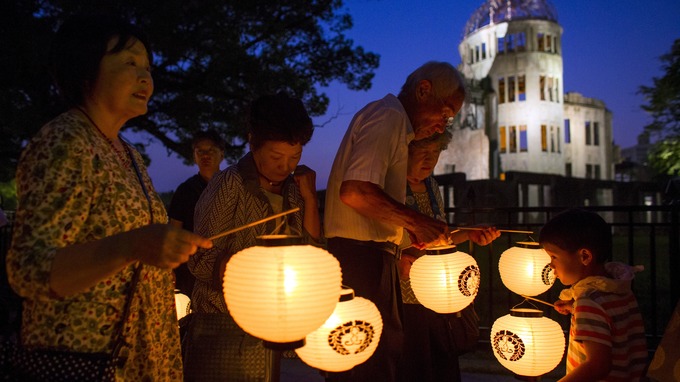 |
| newsXpress24 |
Services have been held in Hiroshima to mark 70 years since an atomic bomb destroyed the city.
Some 70,000 people were killed instantly in the city when the US bomber Enola Gay dropped the world's first atomic bomb on August 6th 1945.
The death toll would later rise to 140,000.
Some 70,000 people were killed instantly in the city when the US bomber Enola Gay dropped the world's first atomic bomb on August 6th 1945.
The death toll would later rise to 140,000.
Japan surrendered soon after a second bomb targeted Nagasaki, bringing an end to the Second World War.
The country's prime minister Shinzo Abe was joined by US Ambassador to Japan Caroline Kennedy for a prayer service in Hiroshima Peace Memorial Park.
Children also staged a "die-in" in front of the Atomic Bomb Dome, one of the only structures left standing when the bomb hit.
Thousands of paper lanterns will be released on the Motoyasu River later on to symbolise victims' journey to the afterlife.
The country's prime minister Shinzo Abe was joined by US Ambassador to Japan Caroline Kennedy for a prayer service in Hiroshima Peace Memorial Park.
Children also staged a "die-in" in front of the Atomic Bomb Dome, one of the only structures left standing when the bomb hit.
Thousands of paper lanterns will be released on the Motoyasu River later on to symbolise victims' journey to the afterlife.
 |
| newsXpress24 |
 |
| newsXpress24 |
 |
| newsXpress24 |
 |
| newsXpress24 |
 |
| newsXpress24 |
 |
| newsXpress24 |
 |
| newsXpress24 |
 |
| newsXpress24 |
The horrors of an Atomic Attack in Hiroshima and Nagasaki

Survivors of the atomic attacks in Japan have shared their
experiences of the devastating attacks in powerful testimony and how
those two bombs changed their lives forever.
Hiroshi Harada still remembers how his leg sank into one of the bodies blocking a narrow street in the city as he fled the spreading fires after the bomb was dropped.
He also recalls stepping back in horror after a young girl grabbed him to ask for water and he noticed a chunk of flesh from her hand had stuck to his leg.
The 75-year-old said:
Hiroshi Harada still remembers how his leg sank into one of the bodies blocking a narrow street in the city as he fled the spreading fires after the bomb was dropped.
He also recalls stepping back in horror after a young girl grabbed him to ask for water and he noticed a chunk of flesh from her hand had stuck to his leg.
The 75-year-old said:

Hiroshima survivors often refrain from talking about their
experiences even with their own children, some from a feeling that the
past is too horrific.
Makiko Kato, an 85-year-old who was hit by the
explosion just 1.2 km (0.8 miles) away from ground zero at Hiroshima, is
one of those survivors.
She has led her life without ever telling her children or grandchildren what she went through.
She has led her life without ever telling her children or grandchildren what she went through.
 |
| newsXpress24 |
Speaking at a home for elderly atomic bomb survivors in the city,
the 85-year-old said: "Recently I have begun to think I need to tell
them (her children) because, at this age, there's no guarantee that I'll
be able to live to see tomorrow."

Fumiaki Kajiya, 76, is a former school teacher who took up painting to teach children about his experiences of the bombing.
He lost his sister to the atomic blast. Their parents had moved her to a rural area to keep her safe, but just before the bombing, they brought her back to the city, succumbing to her pleas to stay with the family.
While the rest of his family managed to survive, the memories of the trauma and the sight of his mother weeping for hours on end in front of a buddhist altar every August 6th, led him to become a strong anti-nuclear advocate.
The bombings at Hiroshima and Nakaski helped stop the war but
ruined two cities and left generations of Japanese suffering the
physical and psychological effects of radiation poisoning. He lost his sister to the atomic blast. Their parents had moved her to a rural area to keep her safe, but just before the bombing, they brought her back to the city, succumbing to her pleas to stay with the family.
While the rest of his family managed to survive, the memories of the trauma and the sight of his mother weeping for hours on end in front of a buddhist altar every August 6th, led him to become a strong anti-nuclear advocate.
Cancer and other related illnesses claimed a further tens of thousands of lives and survivors faced being outcasts in Japanese society.
Mayor of Hiroshima: Abolish nukes for world peace
 |
| newsXpress24 |
Seventy years after the first atomic bomb lay waste to the Japanese
city, the Mayor of Hiroshima has urged the world that to abolish
nuclear weapons and demanded the creation of security systems that do
not rely on military might.
Speaking at the official commemorations at Little Boy's ground zero in theheart of the city, Mayor Kazumi Matsui said:
Speaking at the official commemorations at Little Boy's ground zero in theheart of the city, Mayor Kazumi Matsui said:





